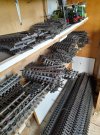Yes.
lgb track is of the highest quality. Robust. Withstands weather, especially the crossties(sleepers). These are where, imho, lgb is worth the cost.
however…..
1 check new prices compared to the sellers. Often, especially now, used track may not be much of a saving over new. (At least on ebay, retail shops) Especially with points. Otoh, track is heavy in quantity, and shipping can be monstrously expensive.
if you can , try to buy about what need for your track plan. Otoh, spares are great, depending upon price…
2 generally speaking, you will want, at the very very least, r2 (5ft diameter)or r3 (8ft diameter). R1 should be cheap as chips….fine to start a small toyish set up, abundant on the market, and, guaranteed to be found a limited utility as your hobby grows, ie, it ends up in a box.
simple ‘truth’ wider curves will look better and run better. 10ft or greater diameter, if you can. I run r3, and i have no issues, even with longer cars, locos and trains. If you run short rolling stock and short trains, you can get by with tighter curves. This too is another thread topic.
3 track does wear. The inside edge of the rail will become rounded, to varying degrees. It may or may not effect utility, but, if worn, when mating with new or less worn track, it can present a sharp transitional inside edge at the joiner. It can be a problem, as flanges can/will catch. Look too for divots…from stalled spinning locos, generally not a big deal.
most critically, check for broken rail attachment tabs (ie spike or rail chairs). When these break, for the most part, depending upon the number broken, there may be more severe running impact, ie the rails are not secured to the ties. On points, imho, this is a big deal.
while nothing is insurmountable, the brain damage my not be worth the savings.
also, look at the rail top surface. It should be smooth. If it was regularly cleaned with a course grit material, it may have tiny but deep scratches that collect dirt.
4 rail joiners can wear out and be so fatigued (if subjected to many repeat joinings) that the may break. They can be replaced. Rail clamps are the ticket, but thats another topic entirely.
imho, apart from the high rail, as opposed to scale heights, lgb is good. It weathers to a nice color. Arist stays bright yellow, different alloy. No experience with piko track.
Track is not the place to skimp. As in horses, no foot, no horse. If your track is poor, you wont enjoy running trains very much.
points especially, are inherently a potential derail issue. Worn, ill fitting or electrically compromised points are a pita, period.
This is not to say dont buy used, but, get value for what you spend. Inspect, know current pricing.
imho, btw, provided you get a track plan and simply assemble it, (as opposed to repeatedly taking things apart and reconfiguring) new track, and points, have value as they fit tightly and will align well. For a time, they will give great conductivity. Worn, grotty, loose fitting joiners will not give the same conductivity. Joiners, btw, can be crimped to again fit tightly. They can be carefully cleaned and deoxidized on the rail contact surfaces. Dirty rail can be polished. (Get a red plastic lgb track cleaning block, regardless of new or used track, btw). However, doing this stuff takes care and time. Thus, inspect and buy wisely.
buying track parts, like replacement switch motors, joiners, sleepers, is expensive now, and can negate any savings quickly.
best of luck.






